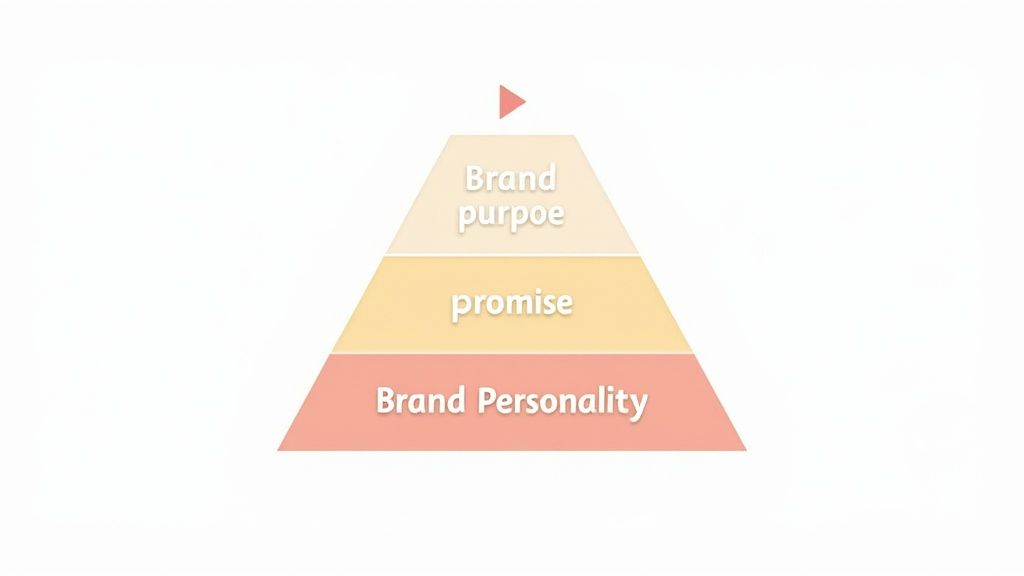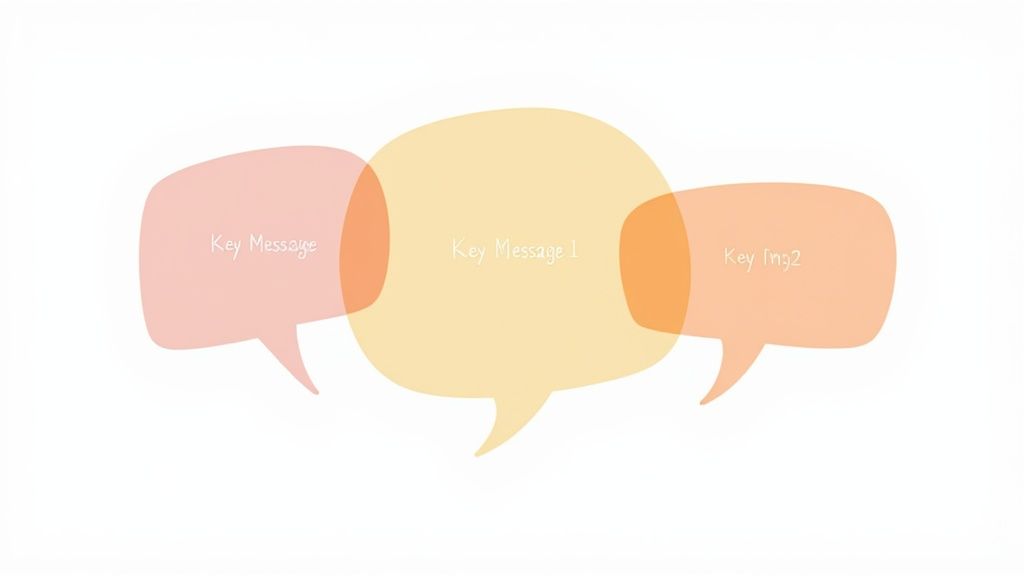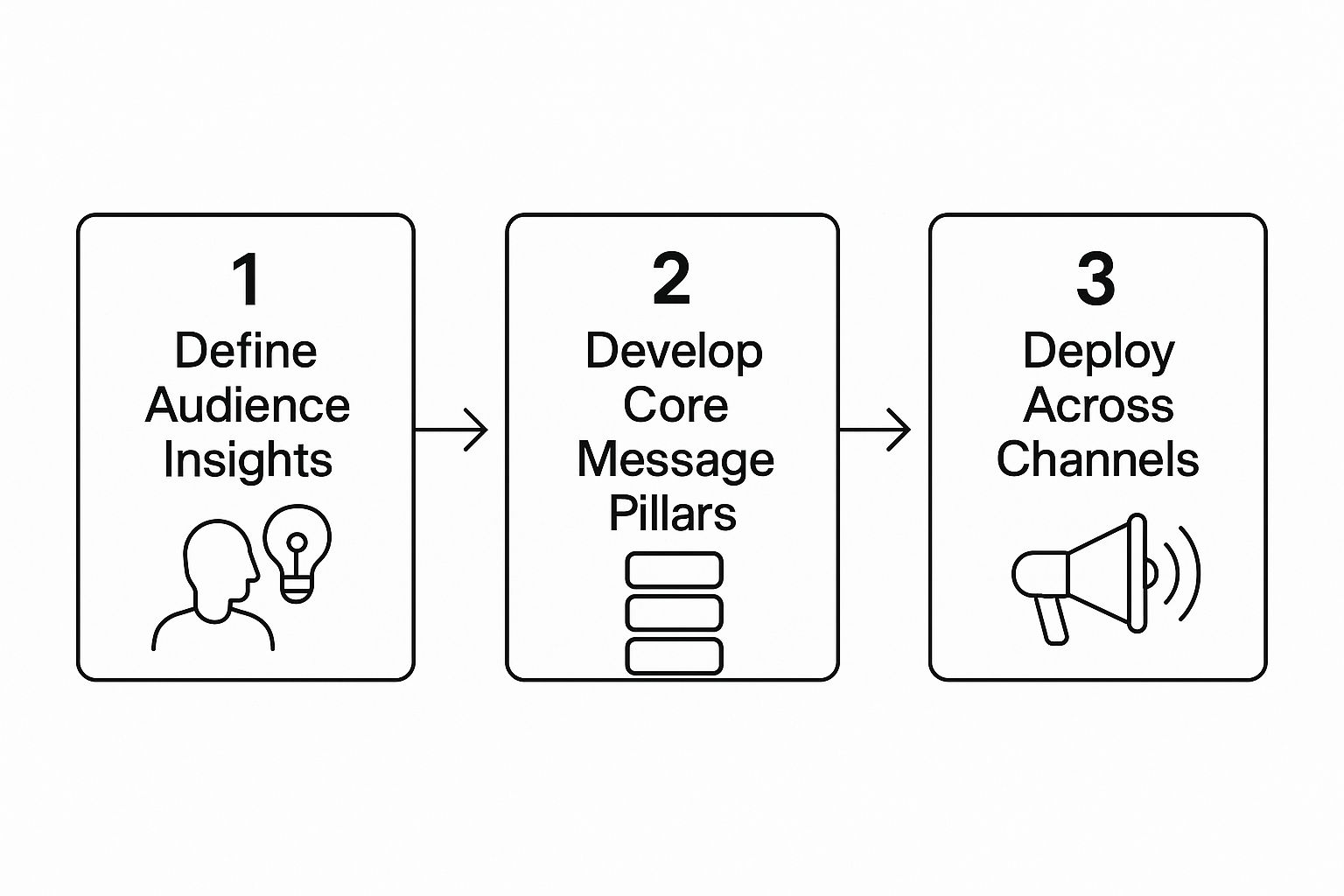Why Your Brand Messaging Framework Makes or Breaks Growth

In today’s competitive landscape, a clear and consistent brand message is essential for success. A brand messaging framework serves as the foundation for all communications, ensuring your brand voice resonates effectively with your target audience. This framework goes beyond simply creating catchy slogans. It involves strategically crafting a narrative that fuels business growth.
The Power of a Unified Message
A brand messaging framework provides the guiding principles for all marketing initiatives. It ensures that every piece of content, from website copy to social media updates, delivers a cohesive and unified message. This consistency builds brand recognition and cultivates trust with your audience.
Consider Nike as a prime example. Their “Just Do It” slogan isn’t just a tagline; it represents a core message woven throughout their communications, inspiring action and resonating with athletes globally. This consistent messaging has contributed significantly to their brand recognition.
A strong framework also promotes internal alignment within your organization. When every team member understands the brand’s core message and values, it streamlines communication and prevents conflicting narratives. This unified approach ensures that sales, marketing, and customer service teams all project a consistent brand identity, strengthening your overall brand image in the eyes of consumers.
The Impact on Business Growth
A well-defined brand messaging framework has a direct impact on your bottom line. By connecting with your audience on an emotional level, you can build brand loyalty and drive conversions. This connection is crucial for differentiating your brand in a crowded market and capturing the attention of potential customers. Building this loyalty can translate into increased sales and repeat business.
A consistent brand message strengthens your value proposition. It clearly articulates what makes your brand unique and why customers should choose you over competitors. This clarity can significantly influence purchase decisions, leading to increased sales and revenue growth.
Consistent brand messaging has a measurable impact on revenue. Studies indicate that 32% of businesses with consistent brand messaging experienced revenue increases of over 20%. This demonstrates the power of a clear and compelling brand identity that resonates with customers and sets your brand apart in competitive markets. Learn more about brand messaging frameworks at Asana.
Beyond Buzzwords: Building a Framework That Works
Creating an effective brand messaging framework requires a thorough understanding of your target audience, your core values, and your unique selling points. It involves developing a system that authentically reflects your brand’s personality and resonates with your ideal customer. This framework should empower your team to communicate effectively and build meaningful connections with your audience, ultimately driving sustainable growth for your business. This understanding should be translated into clear, actionable steps for each department within the organization.
Essential Building Blocks of Powerful Brand Messaging
A brand messaging framework isn’t simply a collection of catchy slogans and taglines. It’s the structured system that communicates your brand’s complete story and ensures consistent messaging across every customer touchpoint. Let’s explore the key components that contribute to a powerful and effective brand message.
Defining Your Core Purpose
The foundation of any successful brand messaging framework starts with a clearly defined core purpose. This goes beyond just stating your business activities. It articulates why your business exists. What problem are you solving for your customers? What value are you adding to the world? A strong core purpose acts as a guiding principle for all your messaging decisions.
For example, Patagonia doesn’t just sell outdoor apparel. Their mission statement, “We’re in business to save our home planet,” reflects a deep commitment to environmentalism, resonating strongly with their target audience. This purpose informs every aspect of their brand communication, from product descriptions to social media campaigns.
Crafting Compelling Value Propositions
Once you’ve established your core purpose, you need to articulate how your brand delivers on that promise. This involves creating value propositions that clearly differentiate your brand from competitors. What unique benefits do you offer your customers? Why should they choose you instead of another brand? Well-crafted value propositions emphasize the distinct advantages you provide and directly address the needs and desires of your target audience.
Establishing Voice and Tone Guidelines
A brand’s voice and tone represent its personality and how it communicates. Voice should remain consistent across all platforms, reflecting your brand’s core values. Tone, however, can be adjusted depending on the specific context and the audience you are addressing. Clear voice and tone guidelines ensure consistent messaging without hindering creativity.
Building Message Pillars
Message pillars are the key themes and topics that support your core purpose and value propositions. They represent the fundamental aspects of your brand story that you want to convey to your audience. These pillars provide a solid framework and focus for all your communication efforts.
To understand how these components work together, let’s consider the following table:
Essential Components of a Brand Messaging Framework
This table outlines the core elements every effective brand messaging framework should include, along with their purpose and impact on overall brand communication.
| Component | Purpose | Business Impact | Implementation Considerations |
|---|---|---|---|
| Core Purpose | Defines the “why” behind the business, its reason for existence. | Provides direction for all messaging, strengthens brand identity. | Requires deep understanding of the business’s mission and values. |
| Value Propositions | Highlights unique benefits and differentiates the brand from competitors. | Improves customer understanding of brand value, drives sales. | Requires market research and competitive analysis. |
| Voice and Tone | Establishes brand personality and communication style. | Ensures consistent brand image, strengthens customer connection. | Requires clear guidelines for different communication channels and target audiences. |
| Message Pillars | Key themes or topics that support the core purpose and value propositions. | Provides structure and focus for communication, reinforces brand messaging. | Requires careful selection of themes that resonate with the target audience. |
| Messaging Hierarchy | Prioritizes different aspects of the brand story based on audience and stage in the buyer’s journey. | Improves message relevance and effectiveness throughout the customer journey. | Requires understanding of the target audience and their needs at each stage. |
This table summarizes the key elements of a successful brand messaging framework, highlighting their interconnectedness and impact on overall brand communication. Each element plays a vital role in crafting a cohesive and compelling brand experience.
Creating a Messaging Hierarchy
Finally, an effective brand messaging framework includes a messaging hierarchy. This prioritizes different aspects of your brand story based on the audience and their stage in the buying journey. A potential customer encountering your brand for the first time will likely need different information than a loyal, repeat customer. A rebranding checklist can be invaluable as you develop your messaging. This hierarchical approach ensures your messaging remains relevant and effective at every point in the customer journey.
By focusing on these key building blocks, you can create a brand messaging framework that resonates with your target audience, sets you apart from the competition, and ultimately drives business results. This structured approach to communication lays the groundwork for a consistent and compelling brand experience.
Connecting Your Message to What Customers Actually Value

A strong brand messaging framework hinges on its connection to customer values. Understanding your audience is paramount. This goes beyond basic demographics. It requires delving into what truly matters to your customers. This understanding is the foundation of a successful brand messaging strategy.
Understanding Your Audience’s Values
Connecting with your audience begins with understanding their values. This involves thorough research to uncover their motivations, aspirations, and pain points. Methods like customer surveys, online review analysis, and social listening can provide valuable insights. This qualitative data reveals the values driving their purchasing decisions.
Crafting a powerful brand messaging framework requires a resonant core message. The importance of clear messaging cannot be overstated: Clear Messaging
Brand messaging has evolved alongside consumer preferences. There’s a growing emphasis on emotional and value-based communication. A recent U.S. survey shows consumers prefer brands prioritizing authenticity, trust, and social responsibility. Honesty, community impact, and sustainability were the top three appealing message types. More detailed statistics can be found here.
Incorporating Values into Your Framework
Authentic integration of audience values into your framework is essential. Align your messaging with these values genuinely and meaningfully. This resonates more deeply than simply following trends.
For example, if your audience values sustainability, showcase your brand’s eco-friendly practices. Demonstrate your commitment with specific actions and initiatives, not just words. This builds credibility and strengthens customer connections.
Testing Message Resonance
Before full implementation, test your messaging. Gather feedback from your target audience to gauge their reactions and ensure your message is received as intended. A/B testing different versions across various channels provides valuable data. This allows for refinement and optimization.
Maintaining a Dynamic Framework
Consumer expectations constantly shift. Maintaining a dynamic brand messaging framework is crucial. Regularly review your research, analyze market trends, and adapt your messaging accordingly. This keeps your brand relevant and resonant with your evolving audience. A dynamic framework allows you to navigate changing preferences while staying true to your core brand identity. This adaptability is key to long-term market success.
Crafting Your Framework: A Step-by-Step Workshop Guide
Transforming brand messaging theory into a practical framework requires a structured approach. This workshop guide helps you build a robust brand messaging framework from scratch. This process ensures your messaging resonates with your target audience and drives business results.
Assessing Your Current Messaging
Begin by evaluating your current messaging effectiveness. Analyze existing marketing materials, website content, and customer communications. Look for inconsistencies, outdated language, or messages misaligned with your current brand identity. This assessment provides a foundation for improvement.
Defining Your Core Purpose and Differentiators
Clearly define your core purpose. What problem does your brand solve for customers? Go beyond product/service descriptions and articulate your unique market value. Then, identify differentiators that set you apart from competitors. Focus on tangible benefits and avoid generic claims.
Articulating Value Propositions
Based on your core purpose and differentiators, craft compelling value propositions. Explain how your brand delivers and why customers should choose you. These value propositions should resonate with your target audience, addressing their needs and motivations.
Navigating Internal Alignment and Testing
Facilitation is key to navigating internal messaging disagreements. Encourage open communication and team collaboration. Next, test message resonance with your target audience. Conduct surveys, focus groups, or A/B testing to gather feedback and refine messaging before widespread implementation. This ensures effective message connection.

This process emphasizes understanding your audience before crafting and deploying core messages across various channels. Starting with audience insights ensures targeted and effective message development and deployment.
Documenting Your Framework
Finally, document your framework in a clear, concise, and accessible format. This document serves as a guide for all teams. Include your core purpose, value propositions, voice and tone guidelines, messaging pillars, and other relevant information. A well-documented framework ensures consistent messaging across all channels and allows for easy updates.
To understand the process of developing a Brand Messaging Framework, let’s look at the table below:
The table “Brand Messaging Framework Development Process” provides a comprehensive overview of the steps involved in creating an effective framework. It outlines the key activities, resources, and expected outcomes for each phase.
| Development Phase | Key Activities | Team Members Involved | Deliverables | Timeline |
|---|---|---|---|---|
| Assessing Current Messaging | Audit existing materials, competitor analysis | Marketing, Sales | Gap analysis report | 2 Weeks |
| Defining Core Purpose & Differentiators | Workshops, stakeholder interviews | Leadership, Marketing | Purpose statement, differentiator list | 1 Week |
| Articulating Value Propositions | Customer research, value proposition development | Marketing, Product | Value proposition statements | 2 Weeks |
| Navigating Internal Alignment & Testing | Presentations, feedback sessions, A/B testing | Cross-functional team | Refined messaging document | 3 Weeks |
| Documenting the Framework | Framework creation, distribution, training | Marketing | Finalized framework document, training materials | 1 Week |
This table highlights the collaborative nature of framework development and the importance of clearly defined deliverables and timelines. Each phase builds upon the previous, resulting in a robust and actionable framework.
Consider using a shared online document like those available in Google Workspace or Microsoft 365 to facilitate collaboration and ensure everyone has access to the latest version. This simplifies training and maintains consistency. Through this structured approach, your brand message will resonate with your target audience, reinforce your brand identity, and drive business growth. Remember, your brand messaging framework is a living document, subject to ongoing review and refinement.
Bringing Your Messaging to Life Across Every Channel

Developing a strong brand messaging framework is just the first step. The true impact comes from activating that framework across every channel where your brand connects with its audience. This involves strategically tailoring your core message to resonate effectively within the specific context of each platform, ensuring a consistent brand experience across all touchpoints.
Channel-Specific Strategies for Consistent Messaging
A successful brand messaging framework needs to be adaptable, not fixed. Your core message should remain constant, but its delivery should be adjusted for each channel. For example, the brief, impactful style of a tweet will differ significantly from the more detailed approach of a blog post.
- Website Content: Your website is your brand’s digital headquarters. Use your brand messaging framework to shape your website copy, ensuring a consistent brand voice and clearly communicating your value proposition.
- Social Media Posts: Adapt your message for the specific platform and audience. A LinkedIn post might focus on industry insights, while an Instagram post could showcase brand personality through visuals and compelling stories.
- Email Campaigns: Craft compelling subject lines and body copy that resonates with your subscribers and encourages desired actions, all based on your established framework.
- Sales Presentations: Align your sales pitches with your brand messaging framework to deliver a cohesive and persuasive narrative that highlights your key benefits and sets you apart from the competition.
- Customer Service Scripts: Provide your customer service team with messaging guidelines, ensuring they consistently represent your brand and resolve customer issues effectively.
- Internal Communications: Foster clear and consistent communication within your organization by using your framework to align all team members with your brand’s core message.
Creating Channel Guidelines
To maintain consistency, develop channel-specific guidelines outlining the appropriate voice, tone, and style for each platform. These guidelines ensure adherence to the core principles of your brand messaging framework, empowering team members to communicate effectively and maintain brand integrity.
Empowering Your Team
Investing in training for your team to confidently use the brand messaging framework is essential. This empowers every team member to become a brand ambassador, consistently representing your brand in all communications. Provide clear examples and practical exercises to reinforce key concepts and build confidence.
Maintaining Authenticity
Adapting your message for different channels shouldn’t mean sacrificing authenticity. The goal is to translate your core message into language that resonates within each context, while staying true to your brand’s unique voice. This builds genuine connections and fosters trust with your audience, ultimately strengthening brand loyalty and driving long-term success.
Measuring Whether Your Messaging Actually Works
Creating a solid brand messaging framework is a significant investment. But how do you know if it’s truly working? It’s essential to go beyond intuition and surface-level metrics to understand if your messaging resonates with your target audience and drives tangible business results. This section explores how to measure the true impact of your brand messaging.
Key Performance Indicators for Messaging Success
Measuring the effectiveness of your messaging requires focusing on specific Key Performance Indicators (KPIs). These metrics provide valuable data on how your messaging is performing.
Awareness and recall metrics show how well your audience recognizes and remembers your brand. Tools like brand tracking studies and surveys are effective ways to measure these metrics.
Sentiment analysis, gathered through social listening and customer feedback, reveals how your audience feels about your brand and its messaging. This helps understand the emotional connection (or lack thereof) that your messaging creates.
Finally, conversion attribution links your messaging to concrete business outcomes, such as sales and lead generation. Tracking these KPIs offers insights into which messaging elements are working and which need improvement.
Quantitative and Qualitative Measurement Methods
A comprehensive measurement strategy uses both quantitative and qualitative methods.
Quantitative methods leverage numerical data to assess performance. Think website analytics, conversion data, and structured surveys. These offer concrete data points to track progress.
Qualitative methods delve deeper into the why behind audience reactions. Customer interviews and social listening provide nuanced insights through direct interaction. They offer a richer understanding of audience perceptions.
Combining these approaches paints a complete picture of your messaging’s effectiveness.
Establishing Baselines and Ongoing Review
Before launching your new messaging framework, establish baseline measurements for your chosen KPIs. This benchmark allows you to accurately gauge the impact of the new messaging against previous performance.
Regular review and refinement are essential. Analyze your performance data frequently, and don’t be afraid to adjust your messaging based on what you learn. This iterative approach ensures your brand messaging stays relevant and effective over the long haul. By consistently adapting to market feedback, your messaging can better meet the evolving needs and preferences of your audience.
For a comprehensive approach to strengthening your brand’s voice and maximizing the impact of your messaging, consider partnering with ReachLabs.ai. Their team of experts provides tailored digital strategies and creative solutions, using data-driven insights to help you achieve your business objectives.





